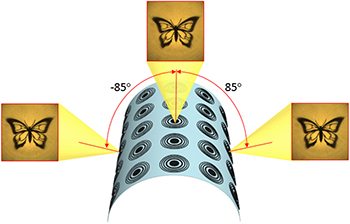
Field of view of a microlens array on a curved shape. Credit: Sci. Reports, doi: 10.1038/srep15861
University of Wisconsin – Madison (USA) engineer Hongrui Jian and colleagues took inspiration from the dome-shaped compound lenses of insect eyes to create tiny, flexible Fresnel lens arrays that provide an impressive 170-degree field of view at a fraction of the size of traditional lenses (Sci. Reports, doi: 10.1038/srep15861). The Fresnel zone plates (FZPs) consist of several 0.5-mm-diameter lenses embedded in a sheet of flexible plastic. In addition to the FZPs flexibility, the lenses themselves are tunable—a feat not possible with rigid refractive lenses. The engineers say their FZPs could prove useful in many applications, including medical imaging, contact lenses and surveillance cameras.
To make the bullseye-patterned Fresnel microlenses tunable, Jian and his team needed to make them flexible. And, to obtain crisp images from these lenses, the alternating dark-light rings needed to be as dark and as bright as possible. The light rings were made of 100-nm thick aluminum that transmits over 95 percent of the visible spectrum. However, getting the dark rings dark enough had been an issue with previous FZP designs.
The team overcame this issue by using black silicon for the dark rings, which absorb 98 percent of the visible spectrum. Black silicon is made up of a forest of vertical silicon nanowires. When light hits the black silicon, it ricochets off the nanowire “trees” and can’t escape, making the dark rings exceptionally dark.
To incorporate black silicon into their Fresnel microlens design, the engineers placed patterned aluminum rings on top of a solid silicon wafer. They etched nanowires into the silicon located between the aluminum rings. Next, they poured a flexible polymer called polydimethylsiloxane over the etched silicon. After the polymer cured, the rigid silicon backing was etched away with sulfur hexafluoride. The resulting binary (alternating dark and light rings) Fresnel lens is, according to the authors, “lightweight, compact and capable of providing high numerical apertures.”
They demonstrated their FZP design’s ability to provide high-resolution imaging of objects located at different axial and angular positions—in this case, university mascot Bucky Badger and a butterfly printed on an transparency—by placing a half-cylindrical array in front of a microscope lens. Images from individual lenses in the array, taken at the same time, were captured using a CCD camera and were stitched together to produced clear, panoramic fields of view of both Bucky and the butterfly.
